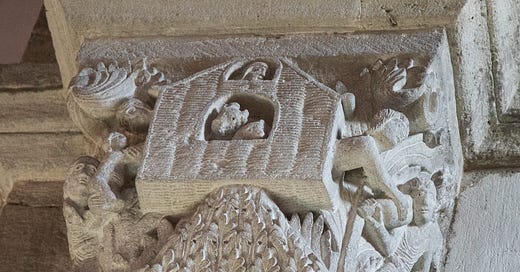I chose this image from a capital in the Cathedral of Saint Lazarus in Autun as an illustration for my comments on my birthday post October 1.
My wife looked at it with me a few days ago, and as I explained some of the esoteric meaning in it, she observed it might be worthwhile to write about it.
So okay.
A superficial study of this image looks like it’s about the birth of Christ, with the central icon in the upper half of the image being the manger in which he was born. Indeed it is, and this is an easy place from which to understand the image; and yet there’s much more going on here.
First of all, one can remember that Christ became human; and in that sense His birth and life reflect every human birth and life, so this is an allegory not just about Christ and His life, but about all of our lives. So this image represents not just Christ’s birth, life, and death, but the birth, life, and death of all humanity. It contains, in other words, information about the nature of human life itself. The genius of the iconographers and symbolists in the Middle Ages is very much on display here in this relatively small stone carving. They managed to put an extraordinary amount of information in a very simple image.
Keep reading with a 7-day free trial
Subscribe to Zen, Yoga, Gurdjieff: Lee's Gurdjieff Newsletter to keep reading this post and get 7 days of free access to the full post archives.





